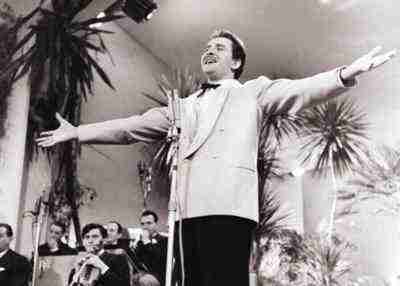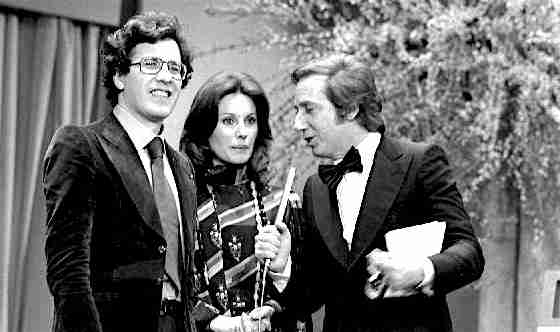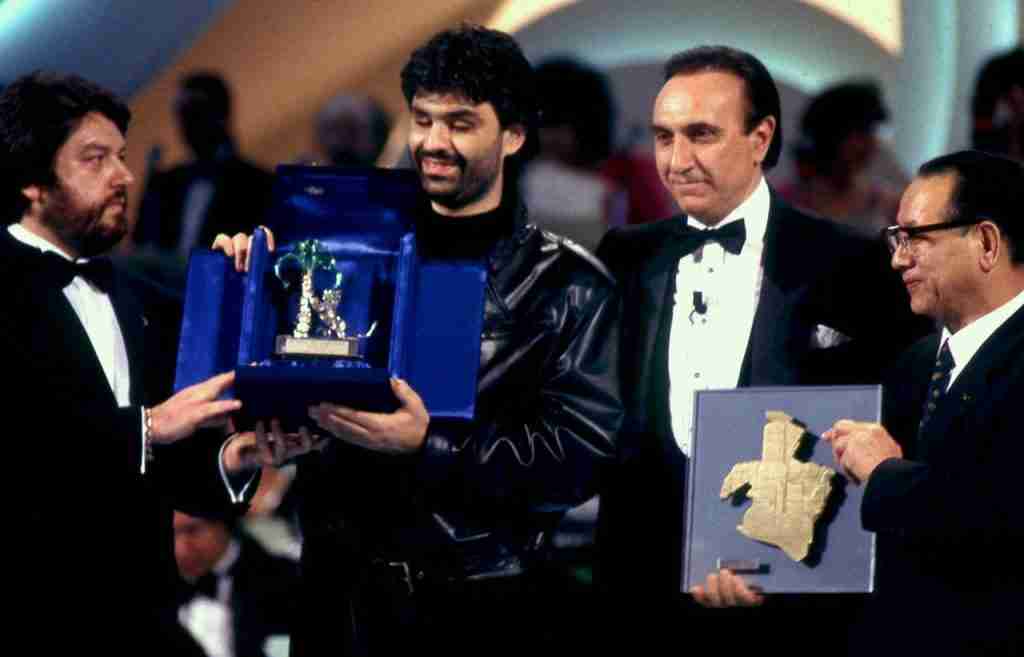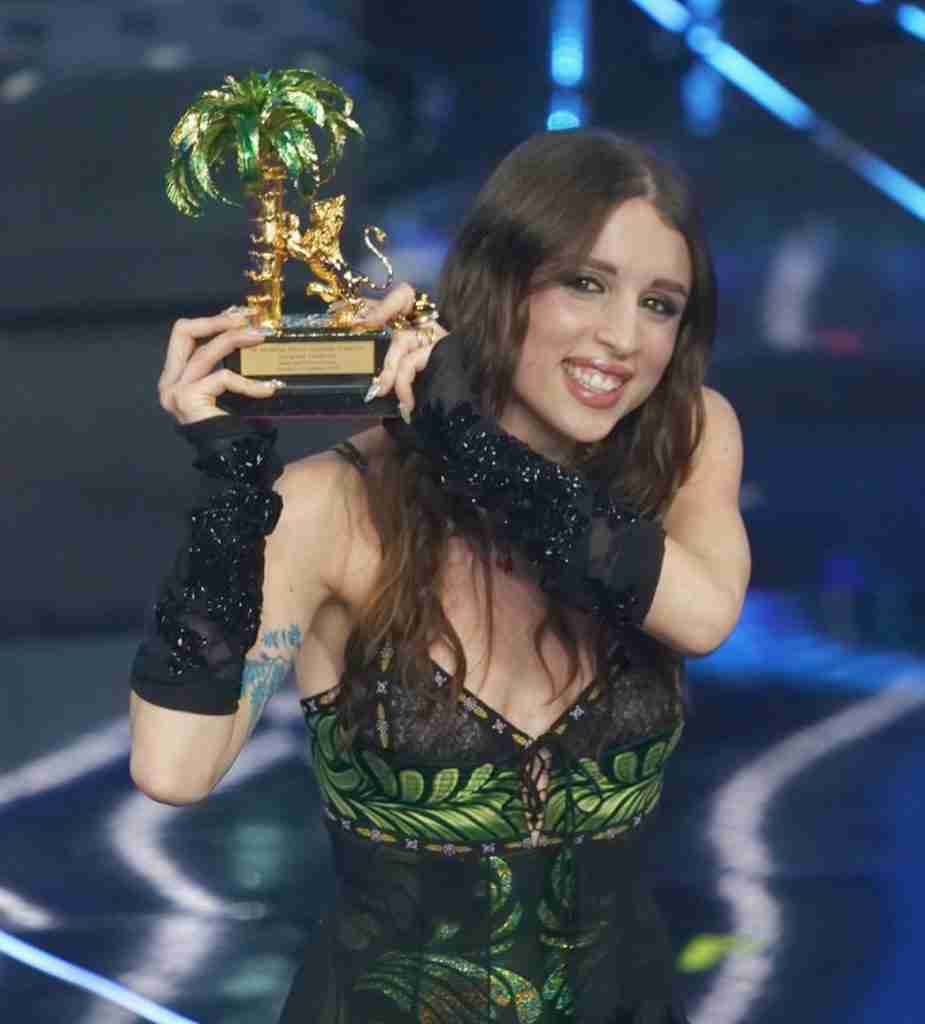The Sanremo Music Festival, held annually in the picturesque seaside town of Sanremo, Italy, has become a beloved Italian pop culture institution ever since it began in 1951 as a means to help rebuild Italy’s music industry following World War II. Over the past 70+ years, the iconic song competition has evolved into a massive television event on par with the Grammy or Eurovision contests, routinely drawing over 13 million Italian viewers each night of the week-long festival.
Sanremo Music Festival: the origins
In 1932, during a period of increased tourism in Sanremo, the operator of the local municipal casino, Luigi De Santis from Naples, put together a holiday celebration of Neapolitan music. This event, dubbed the Neapolitan Festival of Songs, Traditions, and Customs, was held in the casino’s ballroom from December 24, 1931, to January 1, 1932, and was documented by the fascist regime’s film crews. Among the attendees was a young local floriculturist, Amilcare Rambaldi, who was 20 years old at the time. After World War II, in 1945, Rambaldi, a former member of the partisan resistance, was tasked by the National Liberation Committee with devising events to rejuvenate the city’s economy. Recalling the Neapolitan festival’s success from fourteen years prior, he suggested organizing an Italian song contest in the casino’s party room.
However, this suggestion was initially dismissed. Meanwhile, the town of Viareggio, ahead of Sanremo, launched its own Italian Song Festival on August 25, 1948, at Sergio Bernardini’s “Capannina del Marco Polo”. This initiative, led by Alberto Sargentini, head of the local Celebrations Committee which also organized the renowned Viareggio Carnival, and Aldo Valleroni, managed to bring the singing contest to life to liven up the summer season. Despite its success and a repeat the following summer, the event was discontinued after 1949 due to financial constraints. The 1948 Viareggio event was broadcast live on radio, hosted by Amerigo Gomez from RAI Florence, featuring an orchestra conducted by Maestro Francesco Ferrari and the participation of ten singers, including Narciso Parigi, Brenda Gjoi, and Silvano Lalli. The organization also included Aldo Angelini, director of RAI Florence, Silvio Della Rovere, a publisher from Rome, and Giancarlo Fusco. Funding was provided by the Celebrations Committee and Sergio Bernardini, with additional support from U.S. troops stationed at Camp Darby and local parishes for equipment and seating. Pino Moschini’s “Serenata al primo amore” won the contest. The festival was held again on August 25 the following year, with increased investment and featured “Il topo di campagna” by Narciso Parigi, replicating its previous success. In 1950, the Viareggio Carnival faced setbacks due to bad weather, leading to budget cuts that affected the Song Festival. When additional funding was sought from a hospitality company and denied due to skepticism about the event’s potential, the festival could not continue. The discontinuation of the Viareggio festival in 1948 and 1949 indirectly paved the way for the creation of the now-famous Sanremo Music Festival. Pier Busetti, the manager of the Sanremo casino and a summer visitor to Viareggio, had been a spectator at the Viareggio festivals, drawing inspiration from them for Sanremo.
Sanremo Music Festival: humble Beginnings
The origins of the festival date back to late 1950, when Italian RAI radio director Giulio Razzi came up with the idea to hold a competitive live music event to attract more listeners. Razzi teamed up with flower exporter and Sanremo Casino director Pier Busseti to organize it and the first annual Sanremo Music Festival was held from January 29th to February 3rd, 1951 at Sanremo’s Casino Theater, drawing 20 singers performing a total of 40 songs over the 5 days. Artists were accompanied by a 25-piece orchestra conducted by Maestro Cinico Angelini with Trio Lescano providing additional vocals. The inaugural event was hosted by pioneering TV presenter Nunzio Filogamo and was broadcast by RAI radio with one night also airing on Italy’s sole TV channel at the time. Despite the basic production, it was a hit across the country, with “Grazie dei Fiori” performed by Nilla Pizzi and Duo Fasano emerging as the first winner. The festival continued on radio annually for most of the 1950s, except for in 1953 and 1954 when it took a brief hiatus.
Sanremo Music Festival: gaining popularity on Television
When the Sanremo Festival returned in 1955, a recently launched second RAI channel decided to start broadcasting it on television as well, exposing it to more Italians. As the national TV audience steadily grew over late 1950s into the 1960s, so too did the Sanremo Festival’s viewership and impact. Big names of the times like Domenico Modugno, Claudio Villa, and Johnny Dorelli became fixtures, turning their Sanremo victories into enormous record sales and fame. Modugno’s win in 1958 with “Nel Blu Dipinto di Blu” (known as “Volare”) encapsulated the growing spectacle, as his operatic performance ushered Italian music into new creative territories at the dawn of the rock era. Italy was captivated, with the song going on to become one of the biggest international Italian crossover hits ever. During this golden age of traditional Italian pop music, the Sanremo Festival became a beloved late-Winter TV ritual across generations. Even legends like Louis Armstrong and Frank Sinatra performed on its stage in 1962 and 1967, respectively.

Sanremo Music Festival: reflecting social change
As cultural tides started rapidly changing in the late 1960s, so too did the Sanremo Festival. 1968 saw a youth-centered revolt, with contestants abandoning traditional string-backed ballads for protest songs and embryonic rock. Artists like Bobby Solo performed while wearing fashionable mod clothes, as judges severely restricted long hair and English lyrics. The 1960s began with the Italian Society of Authors and Publishers (SIAE) unexpectedly prohibiting its members from participating in the 1961 Sanremo Music Festival, a decision that was largely ignored by its members. This period marked the onset of what came to be known as the “Bongiorno era,” with Mike Bongiorno hosting the festival from 1963 to 1967. This era saw the debut of iconic performers such as Mina, who, after failing to secure a top spot in 1961, vowed never to compete in the festival again, alongside Adriano Celentano, Bobby Solo, and singer-songwriters like Gino Paoli and Umberto Bindi, as well as beat groups, despite facing organizational challenges. Melodic tunes predominantly captured the festival’s top honors, with Gigliola Cinquetti’s victory in 1964 with “Non ho l’età (per amarti)” standing out, a song that also brought her Eurovision Song Contest success that same year. The 1964 festival also welcomed international artists for the first time, aiming to foster a musical exchange between Italian and international talents and to promote Italian music abroad. However, this inclusion of foreign artists was short-lived, ending by the 1966 festival. The stage of Sanremo also began to reflect societal themes and protest. In 1966, Adriano Celentano’s “Il ragazzo della via Gluck” was eliminated early on, while the 1967 edition highlighted youth revolution themes with songs like Gianni Pettenati’s Rivoluzione and Proposta by I Giganti. The 1967 festival is notably marked by the tragic suicide of Luigi Tenco, after his song “Ciao amore ciao” was eliminated, signaling the end of Sanremo’s golden era and heralding a period of upheaval for Italy and the festival narrative.
Mike Bongiorno, during the festival, subtly mentioned Tenco’s death without naming him, symbolizing a transition period for the country and the festival. Despite these challenges, the 1968 festival, hosted for the first time by Pippo Baudo, showcased the rise of singer-songwriters with Sergio Endrigo’s win seen as a posthumous tribute to Tenco. Debuting artists such as Fausto Leali, Al Bano, and Massimo Ranieri represented the diverse youth of the era. The festivals from 1969 to 1971, along with the successes of artists like Lucio Dalla and Roberto Vecchioni in the early 1970s, failed to mask the festival’s declining relevance. In 1971, Rai shifted its focus away from the Neapolitan Song Festival and from 1973, chose to broadcast only the Sanremo Festival’s final evening. This period also saw the festival being critiqued for leaning towards superficial eroticism and stereotypes, reaching a low point in 1975 with a disconnection from reality. Despite these challenges, the festival experimented with various formats, including dividing competitors into categories and replacing the orchestra with backing tracks. The festival eventually moved from the Casino to the Ariston Theatre, a change initially due to renovations but later made permanent, marking a new chapter in the festival’s history.

Sanremo Music Festival: ups and downs transitioning into the modern era
In 1984, Pippo Baudo took over hosting duties (the first of many stints) while iconic 80’s artist Vasco Rossi performed “Vita Spericolata”, thrilling crowds despite weak TV viewership that year. This kicked off a tricky transitional period for the contest. Seeking youth relevance, organizers started allowing established foreign pop acts like Duran Duran to partecipate amid controversial format changes throughout the late 80s and early 90s. Ratings dropped sharply by 1992, widely attributed to Italy’s preference towards dance music combined with a lack of unity around genre or purpose. Behind the scenes, financial troubles plagued parent company RAI, hampering the ability to book talent and modernize production values. Some called for Sanremo to be cancelled altogether despite its great history. However, when Italian crooner Andrea Bocelli gave his first breakout performance singing “Il Mare Calmo della Sera” in 1994, itcreated a much-needed poetic and operatic moment. This planted important seeds leading to a big comeback.

Sanremo Music Festival: return to glory
In 1999, popular host Fabio Fazio took charge of Sanremo alongside movie star Laetitia Casta and conductor Claudio Baglioni. Baglioni went on to assume the unique dual role of host and creative director for a remarkable five straight years, helping substantially revitalize the aging festival. His ambitious vision finally aligned the event with rapidly evolving music trends, while still adhering to traditions. Surprise artists suddenly started emerging from reality shows like Amici alongside respected vets. Most importantly, Baglioni focused on emotional Italian ballads sung in native language that forged connections between young and old. His formula clicked with audiences, stabilizing ratings while launching new stars like Giorgia. Veterans also received their due, including catches like Alex Britti accompanying Pino Daniele on guitar in 2002 for a spellbinding “Quando” duet. Critics again venerated Sanremo as a formidable pop culture force and TV event second only to Italy’s legendary sports coverage.
Sanremo Music Festival: modern juggernaut status
The 2000s saw Sanremo fully consolidate into a contemporary juggernaut on par with fellow state-backed European musical events. In 2006, the nightly show averaged a 45.5% national audience share while concerts and ceremonies captured up to 58% at times. Viewership broke the 50% average mark in 2009 when internationally renowned musician Gianni Morandi co-hosted alongside popular entertainers Belen Rodriguez and Elisabetta Canalis. In the 2010s, the broader variety format expanded even more, enabling respected hosts like Roberto Benigni to inject humor and poignancy around societal issues. Production budgets ballooned, permitting organizers to book Britain’s Got Talent’s Susan Boyle in 2012 alongside luminaries like Bob Dylan and Queen. Performances started garnering millions of real-time YouTube views, underlining global interest. Respected icons Tony Renis and Carlo Conti each had extended hosting runs, leveraging experience to seamlessly blend comedy, advocacy, and music. In 2015, Italy’s public voted internationally celebrated tenor’s band Il Volo’s “Grande Amore” as the contest’s winner. The song went on to claim third-place at that year’s Eurovision, amplifying hype. The accompanying album became Italy’s best-selling debut ever, signaling a full circle moment. Established modern singer Emma Marrone also earned acclaim for an emotional 2014 victory performing “La Mia Città” about overcoming adversity and following dreams. It reflected both her personal journey launching on talent show Amici and a universal message anyone could relate to. The tournament’s recent production bonanza has featured elaborate sets and special effects underscoring world-class status. Respected icons share the stage with newer faces like Mahmood, showcasing Italy’s diversity. Public voting Debate around relevance has been fully ceded to proud celebration of Sanremo as an enduring national institution. 2024’s record-setting ratings only confirm the contest’s incredible resonance across society.

Sanremo Music Festival: why is it so popular in Italy?
The Sanremo Music Festival has managed to not just survive but thrive over 70+ years for several important reasons tied to Italian culture:
- Uniting generations and regions: Sanremo provides rare appointment television that bonded families across age groups in a nation where multi-generational households are common. Its emphasis on iconic melodies sung in Italian transcends regional dialects.
- Promoting excellence and creativity: Italians take pride in the songs, performances and production values as representing the peak of their music industry each year. In particular, Sanremo has showcased opera crossover artists like Andrea Bocelli to great success.
- Celebrating cultural heritage: Hearing classic musicians like Tony Renis alongside modern rap and trap artists allows viewers to feel connected to rich cultural traditions while also partaking in global trends. This continuity is comforting.
- Encouraging participation: interactive social components like the public vote make audiences feel invested beyond passive viewing. Talking about and voting for their favorites enhances communal aspects.
- Escape and optimism: for many Italians, Sanremo provides uplifting relief from economic and societal hardships by emphasizing universals around romance, dreams, and celebrating life’s beauty.
Sanremo Music Festival 2024 Edition
The recently concluded 2024 edition of Sanremo was hosted by beloved showman Amadeus for the fifth straight year alongside. The 74th edition of the Sanremo Music Festival was held at the Ariston Theatre in Sanremo from February 6th to 10th, 2024, under the leadership and creative guidance of Amadeus for the fifth year in a row. Throughout the event, he was accompanied by a series of guest co-hosts: Marco Mengoni on the opening night, Giorgia on the second, Teresa Mannino on the third, Lorella Cuccarini on the fourth, and Rosario Fiorello during the grand finale. Stefano Vicario was in charge of directing, with Mario Catapano overseeing cinematography, marking their fifth year in these roles. The set design was crafted by Gaetano and Maria Chiara Castelli. Echoing the structure of the 2022 and 2023 festivals, this year’s competition featured 30 acts, each presenting a unique song in a unified category. Among these, 27 were established artists, and the remaining three were the top performers from the Sanremo Giovani 2023 contest, each debuting a new song distinct from their winning entry in the previous contest. Angelina Mango clinched the victory with her track “La noia,” securing her spot as Italy’s representative at the Eurovision Song Contest 2024 set to occur from May 7th to 11th in Malmö, Sweden. Angelina is the daughter of the late artist Pino Mango who passed away in 2014. The singer winner of the 2024 edition of the Sanremo Festival, thrilled the entire Italian public during the evening dedicated to covers, interpreting a great success of her father called “La Rondine”. Keep following us to discover everything about our LCN App.

